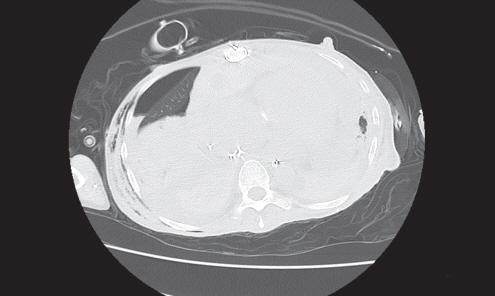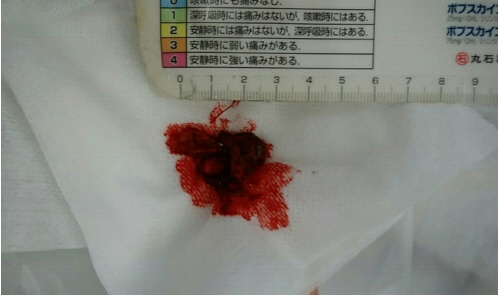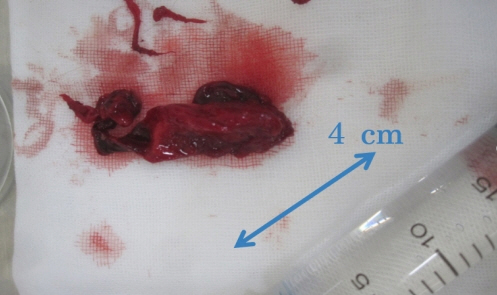Acute Crit Care.
2020 Nov;35(4):298-301. 10.4266/acc.2019.00570.
Fatal airway obstruction due to a ball-valve clot with identical signs of tension pneumothorax
- Affiliations
-
- 1Department of Surgical Intensive Care Medicine, Nagoya University Hospital, Nagoya, Japan
- 2Department of Emergency and Medical Intensive Care Unit, Nagoya University Hospital, Nagoya, Japan
- KMID: 2510550
- DOI: http://doi.org/10.4266/acc.2019.00570
Abstract
- Endo-tracheal tube obstruction due to an extensive blood clot is a recognized but very rare complication. A ball-valve obstruction in the airway could function as a check valve for the lung and thorax, resulting in tension pneumothorax-like abnormalities. A 47-year-old female patient had undergone implantation of a left ventricular assist device 3 weeks prior. On post-operative day 17, planned thoracentesis was performed for drainage of a pleural effusion. Despite the drainage, the patient’s oxygenation did not improve, and emergency tracheal intubation was conducted. Subsequent computed tomography revealed bilateral pneumothorax. Two days later, the patient’s trachea was extubated without complication, and a mini-tracheostomy tube was placed. Three hours later, reintubation was conducted due to progressive tachypnea. Although successful intubation was confirmed, ventilation became increasingly difficult and finally impossible. Marked increase in pulmonary artery and central venous pressures suggested progression of the previous tension pneumothorax. After emergency extracorporeal membrane oxygenation was initiated, fiberoptic bronchoscopy revealed the presence of a massive clot and ball-valve obstruction of the endotracheal tube. Two weeks later, the patient died due to severe hypoxic brain damage. Diagnosis of ball valve clot is not simple, but intensivists should consider this rare complication.
Figure
Reference
-
1. Nolan JD. Prehospital and resuscitative airway care: should the gold standard be reassessed? Curr Opin Crit Care. 2001; 7:413–21.
Article2. Inoue H, Ito J, Uchida H, Morita M, Masuda T, Yamaya K, et al. Lower airway obstruction due to a massive clot resulting from late bleeding following mini-tracheostomy tube insertion and subsequent clot removal and re-intubation. JA Clin Rep. 2017; 3:16.
Article3. Liberman JS, Weigel W, Neal JM. Difficult ventilation after successful intubation in the emergency setting due to a ball valve clot. A Case Rep. 2016; 6:291–2.
Article4. Woittiez KJ, Woittiez AJ. Fatal endotracheal tube obstruction due to the ball valve effect. BMJ Case Rep. 2015; 2015:bcr20142 08189.
Article5. Neuburger PJ, Galloway AC, Zervos MD, Kanchuger MS. Case report: separation from cardiopulmonary bypass with a rigid bronchoscope airway after hemoptysis and bronchial impaction with clot. Anesth Analg. 2012; 114:89–92.6. Kruczek ME, Hoff BH, Keszler BR, Smith RB. Blood clot resulting in ball-valve obstruction in the airway. Crit Care Med. 1982; 10:122–3.
Article7. Haramo A, Shiota N, Fukagawa A, Adachi Y, Nishiwaki K. A small piece of hematoma obstructed the tracheostomy cannula as a check valve. Clin J Anesth (Jpn). 2017; 41:212–4.8. Arney KL, Judson MA, Sahn SA. Airway obstruction arising from blood clot: three reports and a review of the literature. Chest. 1999; 115:293–300.9. Johnson KM, Lehman RE. Acute management of the obstructed endotracheal tube. Respir Care. 2012; 57:1342–4.
Article
- Full Text Links
- Actions
-
Cited
- CITED
-
- Close
- Share
- Similar articles
-
- Tension Pneumothorax and Acute Pulmonary Edema Following Relief of Acute Upper Airway Obstruction
- A Case of Tracheostomy Induced Bilateral Tension Pneumothorax
- Bilateral tension pneumothorax caused by an abrupt increase in airway pressure during cervical spine surgery in the prone position: A case report
- Partial Endotracheal Tube Obstruction Due to Secretions: A case report
- A Case of Endobronchial Urokinase for Relief of Bronchial Obstruction by Blood Clots





